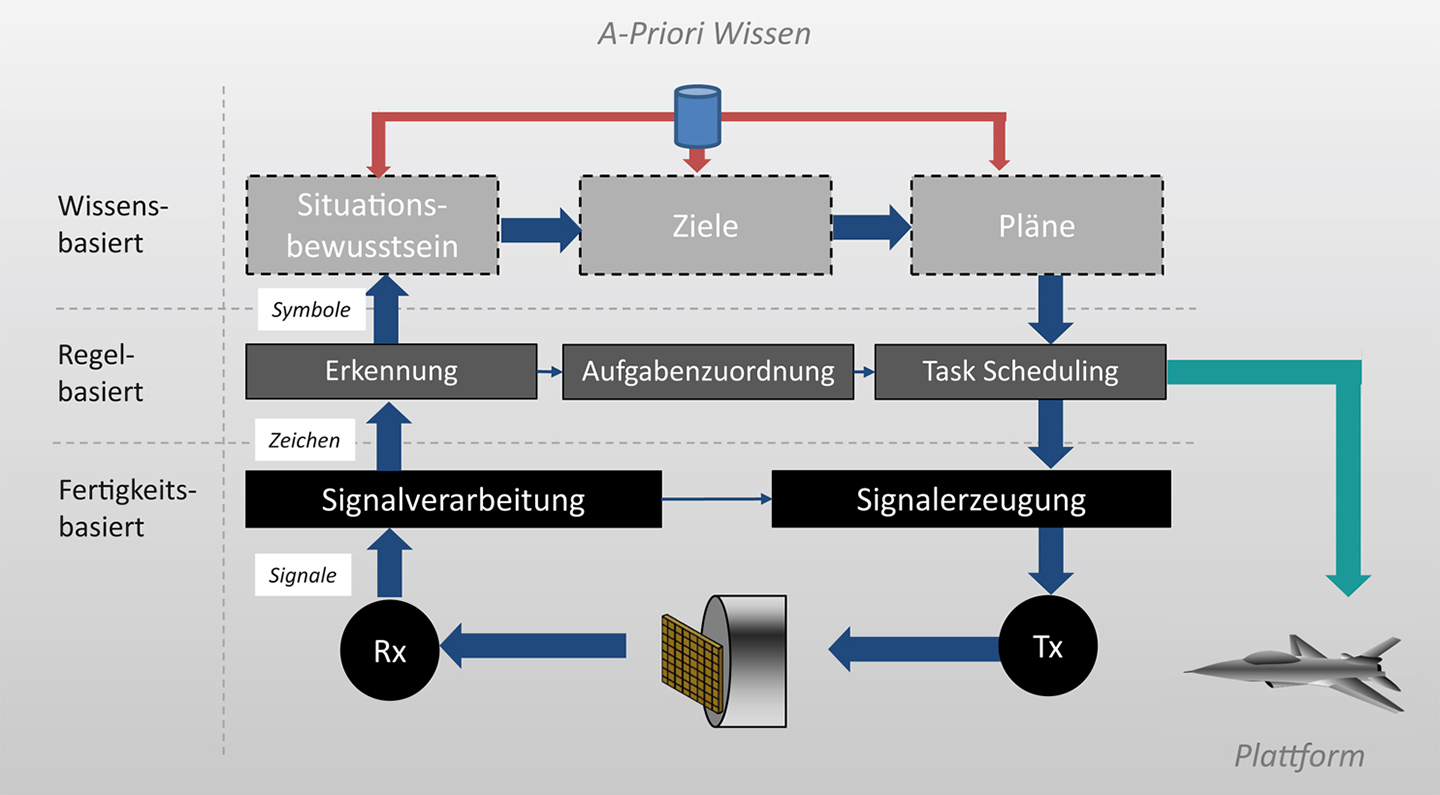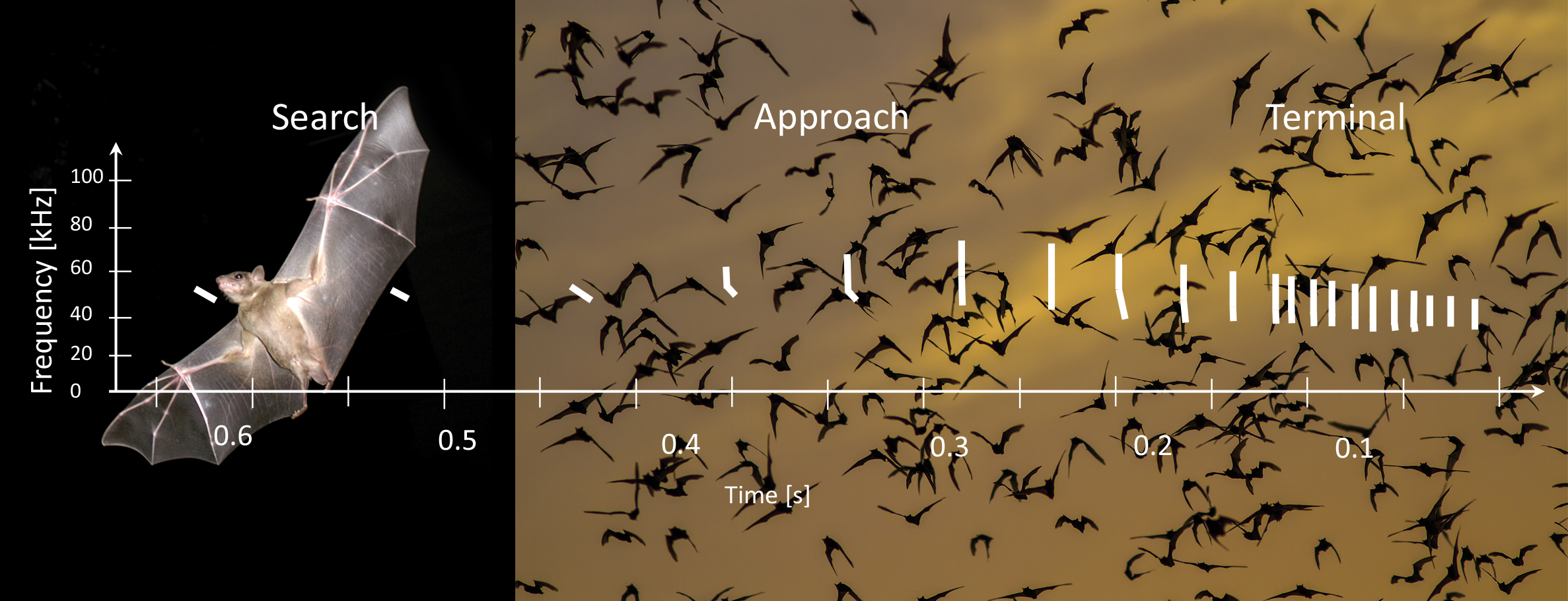A short chirp


In contrast to any other sensor, radar offers numerous degrees of freedom, the efficient handling of which greatly depends on the experience and skill of the operators. Cognitive radar control systems can offer valuable support here. Machine learning techniques and other methods from the field of computer science allow for the partial automation of cognitive abilities and expertise.
Cogito ergo sum
Modern times are characterized by complexity and speed: increasingly difficult decisions must be made in an increasingly short period of time. Situations are becoming more complex and, at the same time, they are changing rapidly. This results in new challenges for people and society and the growing requirements also increase the complexity of the technical systems on which we rely to an ever growing extent. The systems must become more efficient and reach a higher level of automation to provide us with ongoing support in our daily life or at work.
How does this affect radar?
Modern radar systems are intelligent sensors with a large number of software-defined degrees of freedom. They are able to do an increasing number of things at the same time and require highly skilled and concentrated operators. The system, however, is not yet capable of self-optimization on the basis of findings derived from measurements.
Cognitive radar control systems can alleviate this situation. They facilitate an optimal adaptation of the waveform and other parameters to the environment. The young, interdisciplinary research area deals exactly with these issues. The focus lies on research into the depiction of the cognitive abilities of people on suitable hardware and software, in particular their perception and attention control abilities, their ability to solve problems, target-oriented action as well as memory and learning. The research area "Cognitive Radar" combines methods of computer science, such as machine learning techniques and artificial intelligence methods, with traditional signal processing and electrical engineering approaches. The aim is to create a "smart" sensor system that is capable of adapting the waveform and the operating parameters to the scene and the mission context in a dynamic manner. In addition to the closed do-loops between the receive path ("perceptor") and the transmit path ("actuator"), it is also necessary to increase the degree of automation orientated on the human model – but without sighs of fatigue – with a high level of precision and a continuously high level of efficiency.
The conventional distinction between signal processing and information processing as well as sensor control is becoming increasingly blurred and would significantly curtail efficiency. A cognitive radar system can only function if it is cast from a single mould and offers the shortest information run times. In 2012, Simon Haykin formulated his version of a cognitive radar system in his book »Cognitive Dynamic Systems«: »Cognitive approaches would allow us to build a new generation of radar systems that function reliably and precisely and are capable of self-optimization with abilities that are far superior to those of conventional radar.«
The approach adopted by Fraunhofer FHR to link these »cognitive subfunctions« to this efficient system orientates on the »Three-Level Model« of human cognitive performance. This model, which was published by Jens Rasmussen in 1983, is used in cognitive psychology, ergonomics and robotics. A distinction is made between the three behavioral levels which – although vertically structured – are, in principle, all active at the same.
The three levels of Jens Rasmussen
The unconscious, skill-based level is the lowest level. It controls subsymbolic perception and sensorimotor processes, e.g. hand-eye coordination and other reflexes. When applied to cognitive radar, this corresponds to the level of continuous signal processing. It comprises adaptive signal processing methods and provides an estimate of the environment and the transmission channel. While this information has already been used for a considerable time in the perceptor for Space-Time Adaptive Processing (STAP) in GMTI applications, an expansion to the transmit path takes place in cognitive radar. Knowledge-based methods support this process, for instance through georeferenced maps of homogeneous clutter distribution or a-priori known scattering centers.
The above-lying, conscious, rule-based level on the other hand controls reactions which are triggered by certain perceptions from the flow of sensual impressions. These can be described as »routine actions«; things we do casually. In the case of radar, the rule-based behavior level utilizes the recognized scene: the interpretation of the scene from continuous signals based on classification methods and geometric relations. The perceptor-actuator feedback loop that is typical for cognitive radar is implemented in a rule-based fashion, i.e. the reactive transfer of previously defined (learned in simulation runs) sequences to radar tasks or modes. If several of these radar tasks are active at the same time, multi-function radar systems in particular will have to deal with the issue of prioritization or the control of common aperture. Future MIMO arrays will offer additional degrees of freedom through the dynamic selection of orthogonal codings.
The top level makes maximum use of our cognitive abilities and resources, as new solutions have to be created for a previously unknown problem. With regard to sensors and technical devices, the knowledge-based processing layer represents the highest level of abstraction under consideration of external data or interfaces. Such a task- or goal-based radar system exhibits a semantic understanding of the radar scene with respect to the current radar task and is capable of planning a long-term sequence of radar modes in the anticipated mission context. Furthermore, system-engineering and operational concepts play an important role when implementing such a fully integrated, cognitive radar system.
Why we could already build cognitive radar today
The rapid progress in electronic components and highly dynamic, high-speed sampling A/D converters, arbitrary waveform generators, fast processing modules (FPGAs, DSPs) pave the way for the principle of »Software Defined Radars«, which is a basic requirement for the required adaptivity and reconfigurability and is available to Fraunhofer FHR through its FPGA-based system LabRadOR (Laboratory Radar Operating in Real-Time). In particular, the technical hardware solutions for the real-time adaptation of the transmit signal have recently led to a global increase in research into cognitive radar and the experimental testing of these solutions, which has always been of great importance at Fraunhofer FHR.
The dynamic adaptation of the radar parameters to the scene and the mission context, which is mainly realized through software, facilitates the upgrading of existing, conventional radar systems with "cognitive abilities" as well as specially developed highly flexible radar sensors, for example in the area of multi-function radar system for military applications.
An example: the map of the areas that have already been reconnaissanced also shows white unreconnaissanced areas . This gives rise to reconnaissance objectives – such as the mapping of these white areas. Thanks to its library of signal parameters, plans as to how this is to be processed and the order of processing are now created on the actuator side of the cognitive radar system: a short chirp or a long pulse – which is the best solution? The decision is made in fractions of a second. The information is then passed down to task processing and executed. The cycle starts again from the beginning.
Based on the success and failure of earlier radar tasks, the system learns which means are useful or less acceptable. Cognitive radar is intended to strengthen the situational awareness of the operator in complex scenarios and handle low-level operational control decisions : for example, the selection of the optimal operating mode to complete the task – ranging from reconnaissance and surveillance to silent modes or active jammers.
The advantages and versatility of adaptive behavior are also impressively shown in nature in the form of echolocation of bats and dolphins. Thanks to their highly developed and adapted neuronal circuits, they are capable of adapting the pulse repetition rate and length as well as the emitted waveform to the distance to the prey: dolphins can emit chirps with a length of just 120 microseconds; when bats hear an echo they can distinguish a temporal difference of 10 nanoseconds between their two ears. In this way, evolution demonstrates a uniquely efficient and precise combination of sensors and movement trajectory.
